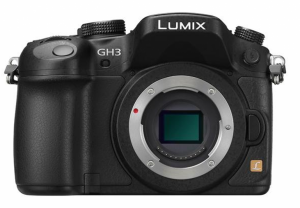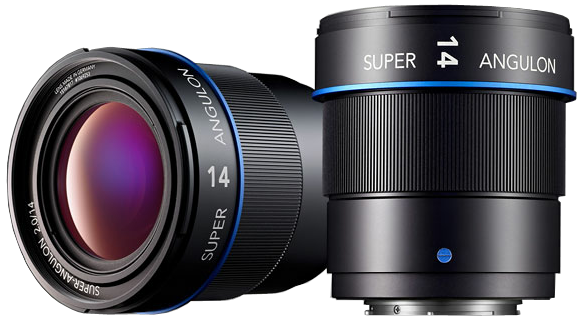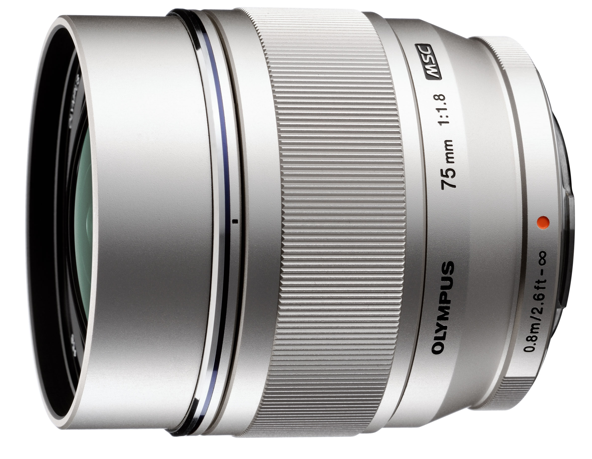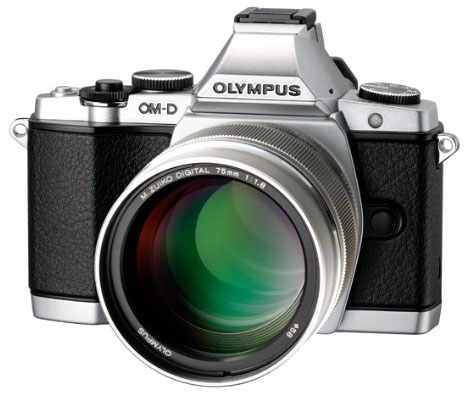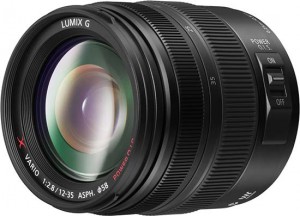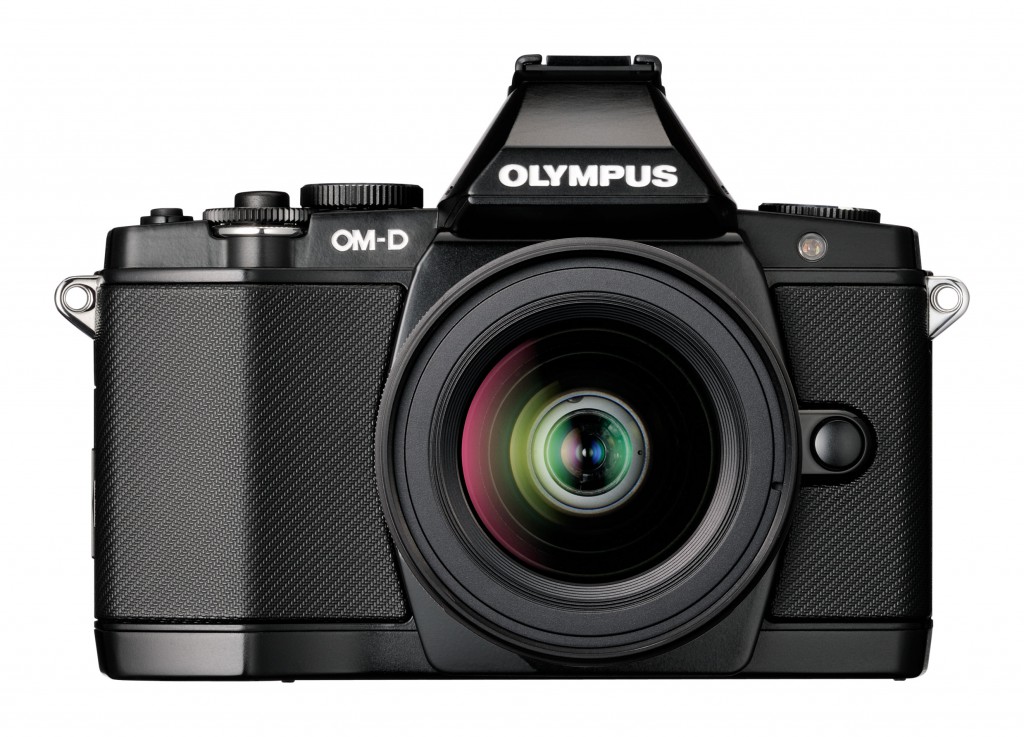| Type |
Digital Single Lens Mirrorless camera |
| Recording Media |
SD Memory Card, SDHC Memory Card, SDXC Memory Card (Compatible with UHS-I standard SDHC / SDXC Memory Cards) |
| Image Sensor Size |
17.3 x 13.0 mm (in 4:3 aspect ratio) |
| Lens Mount |
Micro Four Thirds mount |
| Type |
Live MOS Sensor |
| Total Pixels |
17.20 Megapixels |
| Camera Effective Pixels |
16.05 Megapixels |
| Color Filter |
Primary color filter |
| Dust Reduction System |
Supersonic wave filter |
| Recording File Format |
| Still Image: |
|
JPEG (DCF, Exif 2.3), RAW
MPO (When attaching 3D lens in Micro Four Thirds System standard) |
| Motion Image: |
|
AVCHD Ver 2.0 compliant (AVCHD Progressive),
MPEG4-AVC (H.264). (MOV, MP4) |
|
| Aspect Ratio |
4:3, 3:2, 16:9, 1:1 |
| Image Quality |
RAW, RAW+Fine, RAW+Standard, Fine, Standard
MPO+Fine, MPO+Standard (When attaching 3D lens in Micro Four Thirds System standard) |
| Color Space |
sRGB, Adobe RGB |
| File Size (Pixels) |
Still Image |
[4:3] 4,608 x 3,456 (L), 3,264 x 2,448 (M), 2,336 x 1,752 (S), 1,824 x 1,368 (When attaching 3D lens in Micro Four Thirds System standard)
[3:2] 4,608 x 3,072 (L), 3,264 x 2,176 (M), 2,336 x 1,560 (S), 1,824 x 1,216 (When attaching 3D lens in Micro Four Thirds System standard)
[16:9] 4,608 x 2,592 (L), 3,264 x 1,840 (M), 1,920 x 1,080 (S), 1,824 x 1,024 (When attaching 3D lens in Micro Four Thirds System standard)
[1:1] 3,456 x 3,456 (L), 2,448 x 2,448 (M), 1,744 x 1,744 (S), 1,712 x 1,712 (When attaching 3D lens in Micro Four Thirds System standard) |
| Motion Image |
MOV*1 |
NTSC |
[Full HD] 1,920 x 1,080, 30p (sensor output is 30p, 72Mbps (ALL-Intra))
[Full HD] 1,920 x 1,080, 24p (sensor output is 24p, 72Mbps (ALL-Intra))
[HD] 1,280 x 720, 60p (sensor output is 60p, 72Mbps (ALL-Intra))
[Full HD] 1,920 x 1,080, 60p (sensor output is 60p, 50Mbps (IPB))
[Full HD] 1,920 x 1,080, 30p (sensor output is 30p, 50Mbps (IPB))
[Full HD] 1,920 x 1,080, 24p (sensor output is 24p, 50Mbps (IPB)) |
| PAL*3 |
[Full HD] 1,920 x 1,080, 25p (sensor output is 25p, 72Mbps (ALL-Intra))
[Full HD] 1,920 x 1,080, 24p (sensor output is 24p, 72Mbps (ALL-Intra))
[HD] 1,280 x 720, 50p (sensor output is 50p, 72Mbps (ALL-Intra))
[Full HD] 1,920 x 1,080, 50p (sensor output is 50p, 50Mbps (IPB))
[Full HD] 1,920 x 1,080, 25p (sensor output is 25p, 50Mbps (IPB))
[Full HD] 1,920 x 1,080, 24p (sensor output is 24p, 50Mbps (IPB)) |
| MP4*2 |
NTSC |
[Full HD] 1,920 x 1,080, 30fps (sensor output is 30p, 20Mbps)
[HD] 1,280 x 720, 30fps (sensor output is 30p, 10Mbps)
[VGA] 640 x 480, 30fps (sensor output is 30p, 4Mbps) |
| PAL*3 |
[Full HD] 1,920 x 1,080, 25fps (sensor output is 25p, 20Mbps)
[HD] 1,280 x 720, 25fps (sensor output is 25p, 10Mbps)
[VGA] 640 x 480, 25fps (sensor output is 25p, 4Mbps) |
| AVCHD Progressive*2 |
NTSC |
[Full HD] 1,920 x 1,080, 60p (sensor output is 60p, 28Mbps) |
| PAL*3 |
[Full HD] 1,920 x 1,080, 50p (sensor output is 50p, 28Mbps) |
| AVCHD*2 |
NTSC |
[Full HD] 1,920 x 1,080, 24p (sensor output is 24p, 24Mbps)
[Full HD] 1,920 x 1,080, 60i (sensor output is 30p, 24Mbps)
[Full HD] 1,920 x 1,080, 60i (sensor output is 60p, 17Mbps) |
| PAL*3 |
[Full HD] 1,920 x 1,080, 24p (sensor output is 24p, 24Mbps)
[Full HD] 1,920 x 1,080, 50i (sensor output is 25p, 24Mbps)
[Full HD] 1,920 x 1,080, 50i (sensor output is 50p, 17Mbps) |
| Continuous Recordable Time (Motion Image)*4 |
AVCHD: Approx. 240 min with H-HS12035 / Approx. 220 min with H-VS014140 |
| Actual Recordable Time
(Motion Image)*4 |
AVCHD: Approx. 120 min with H-HS12035 / Approx. 110 min with H-VS014140 |
| Flicker Reduction |
[1/50] [1/60] [1/100] [1/120] / OFF |
| Time Code (Motion Image)
(Except MP4) |
ON / OFF, Count Up: Rec Run / Free Run selectable, Time Code Mode: Drop Frame / Non-drop Frame selectable (NTSC only) |
| Wi-Fi |
IEEE 802.11b/g/n, 2412 MHz – 2462 MHz (11 ch), Wi-Fi / WPA / WPA2, Infrastructure mode |
| Type |
OLED Live View Finder (1,744K dots equivalent) |
| Field of View |
Approx. 100% |
| Magnification |
Approx. 1.34x / 0.67x (35 mm camera equivalent) |
| Eye Point |
Approx. 21 mm from eyepiece lens |
| Diopter Adjustment |
-4.0 – +4.0 (dpt) |
| Auto Eye Sensor |
Yes |
| Focus Type |
Contrast AF system |
| Focus Mode |
AFS (Single) / AFF (Flexible) / AFC (Continuous) / MF |
| AF Mode |
Face detection / AF Tracking / 23-area-focusing / 1-area-focusing / Pinpoint
(Full area touch is available) |
| AF Assist Lamp |
YES (ON / OFF) |
| AF Lock |
Yes (AF/AE LOCK button) |
| Others |
Quick AF, Continuous AF (during motion image recording), AF+MF, Eye Sensor AF, Touch AF, Touch Pad AF, Touch shutter, Touch MF Assist, Shutter AF, Half Press Release |
| Light Metering System |
144-zone multi-pattern sensing system |
| Light Metering Mode |
Intelligent Multiple / Center Weighted / Spot |
| Metering Range |
EV 0 – 18 (F2.0 lens, ISO100 equivalent) |
| Exposure Mode |
Program AE / Aperture Priority AE / Shutter
Priority AE / Manual |
ISO Sensitivity
(Standard Output Sensitivity) |
Auto / Intelligent ISO / 200 / 400 / 800 / 1600 / 3200 / 6400 / 12800 (Changeable to 1/3, 1 EV step)
(Extended ISO125 – less under 200, ISO more over 12800 – 25600 available) (Up to ISO3200 in Auto) |
| Exposure Compensation |
1/3 EV Step, ±5 EV (±3 EV for motion image) |
| AE Lock |
AF/AE LOCK button |
| AE Bracket |
3, 5, 7 frames, in 1/3, 2/3 or 1 EV Step, single / burst |
| White Balance |
Auto / Daylight / Cloudy / Shade / Incandescent / Flash / White Set 1, 2 / Color temperature setting |
| White Balance Adjustment |
Blue/amber bias, Magenta/green bias |
| Color Temperature Setting |
2,500 K – 10,000 K in 100 K |
| White Balance Bracket |
3 exposures in blue/amber axis or in magenta/green axis |
| Type |
Focal-plane shutter |
| Shutter Speed |
Still Images: 1/4,000 – 60 and Bulb
Motion Images: 1/16,000 – 1/30 (NTSC), 1/16,000 – 1/25 (PAL) |
| Self Timer |
10 sec, 3 images after 10 sec, 2 sec |
| Remote Control |
Remote control with Bulb function by DMW-RSL1 (Optional) |
| Still Image |
Clear Portrait / Silky Skin / Backlit Softness / Clear in Backlight / Relaxing Tone / Sweet Child’s Face / Distinct Scenery / Bright Blue Sky / Romantic Sunset Glow / Vivid Sunset Glow / Glistening Water / Clear Nightscape / Cool Night Sky / Warm Glowing Nightscape / Artistic Nightscape / Glittering Illuminations / Clear Night Portrait / Soft Image of a Flower / Appetizing Food / Cute Dessert / Freeze Animal Motion / Clear Sports Shot / Monochrome |
| Motion Image |
Clear Portrait / Silky Skin / Backlit Softness / Clear in Backlight / Relaxing Tone / Sweet Child’s Face / Distinct Scenery / Bright Blue Sky / Romantic Sunset Glow / Vivid Sunset Glow / Clear Nightscape / Cool Night Sky / Warm Glowing Nightscape / Artistic Nightscape / Clear Night Portrait / Appetizing Food / Cute Dessert / Freeze Animal Motion / Clear Sports Shot / Monochrome |
| Burst Speed |
SH: 20 frames/sec (4M), H: 6 frames/sec, M: 4 frames/sec (with Live View), L: 2 frames/sec (with Live View) |
| Built-in Flash |
TTL Built-in-Flash, GN12.0 equivalent (ISO100 · m), GN17.0 (ISO200 · m), Built-in
Pop-up (Reference) |
| Flash Mode |
Auto, Auto / Red-eye Reduction (when iA, iA+), Forced ON, Forced ON / Red-eye Reduction, Slow Sync., Slow Sync. / Red-eye Reduction |
| Synchronization Speed |
Less than 1/160 second |
| Flash Output Adjustment |
1/3 EV Step ±3 EV |
| Flash Synchronization |
1st Curtain Sync., 2nd Curtain Sync. |
| Synchronization for Flash Dimming and Exposure Compensation |
Yes (ON / OFF) |
| Flash Sync Socket |
Yes |
| Monitor Type |
OLED monitor with static touch control |
| Monitor Size |
Free-angle 3.0 inch (7.5 cm) / 3:2 Aspect / Wide-viewing angle |
| Pixels |
614K dots |
| Field of View |
Approx. 100% |
| Monitor Adjustment |
Brightness (7 levels), Color (7 levels), Red-Green (11 levels), Blue-Yellow (11 levels) |
| Live View Digital Zoom |
2x, 4x |
| Extra Tele Conversion |
Still Image: Max. 2x (Not effective with L size recording. Magnification ratio depends on the recording pixels and aspect ratio.)
Motion Image: 2.4x, 3.6x, 4.8x (Magnification ratio depends on the recording quality and aspect ratio.) |
| Other Functions |
Guide Lines (3 patterns)
Real-time Histogram |
| LEVEL GAUGE |
Yes |
| VERTICAL SHOOTING DETECTION |
Yes |
Photo Sytle
Still Image and Motion Image |
Standard / Vivid / Natural / Monochrome / Scenery / Portrait / Custom |
Creative control
Still Image |
Expressive / Retro / High Key / Low Key / Sepia / Dynamic Monochrome / Impressive Art / High Dynamic / Cross Process / Toy Effect / Miniature Effect / Soft Focus / Star Filter / One Point Color |
Creative Control
Motion Image |
Expressive / Retro / High Key / Low Key / Sepia / Dynamic Monochrome / Impressive Art / High Dynamic / Cross Process / Toy Effect / Miniature Effect / One Point Color |
| Video Exposure Mode |
Program AE / Aperture-Priority / Sutter-Priority / Manual Exposure |
| Slow and Fast Motion |
40% / 48% / 80% (Records 0.4 times, 0.48 times, 0.8 times slower)
160% / 200% / 300% (Records 1.6 times, 2.0 times, 3.0 times faster)
(1,920 x 1,080, 24p, 24Mbps in MOV, MP4, AVCHD) |
| Playback Mode |
Normal playback, 30-thumbnail display, 12-thumbnail display, Calendar display, Zoomed playback (Max. 16x), Slideshow (All / Picture Only / Video Only / 3D / Category Selection / Favorite, duration & effect is selectable), Playback Mode (Normal / Picture / Video / 3D Play / Category / Favorite), Title Edit, Text Stamp, Video Divide, Resize, Cropping, Rotate, Favorite, DPOF Print Set, Protect, Face Recognition Edit |
| Image Protection |
Single / Multi, Cancel |
| Image Erase |
Single / Multi / All / Except Favorite |
| USB |
USB 2.0 High Speed |
| HDMI |
mini HDMI TypeC
Video: Auto / 1080p / 1080i / 720p / 480p (576p in PAL system)
Audio: Dolby® Digital |
| Audio Video Output |
Monaural Type, NTSC / PAL, NTSC only for North America
* Check the website of the Panasonic sales company in your country or region for details on the products that are available in your market. |
| Remote Input |
φ2.5mm for remote |
| External Microphone Input |
φ3.5mm for external microphone |
| Headphone Output |
φ3.5mm for headphone |
| Microphone |
Stereo, Wind-cut: OFF / Low / Standard / High / Auto |
| Speaker |
Monaural |
| OSD Language |
English, German, French, Italian, Spanish, Polish, Czech, Hungarian, Russian, Chinese (Traditional), Chinese (Simplified), Dutch, Thai, Korean, Turkish, Portuguese, Arabic, Persian, Japanese, Swedish, Danish, Finnish, Greek, Vietnamese
* Check the website of Panasonic sales company in your country / region or ask customer support for details of the OSD language available on the products sold in your country / region. |
| Battery |
Li-ion Battery Pack (7.2V, 1,860mAh) (Included)
Battery Charger |
| Battery Life (CIPA Standard)*5 |
Approx. 540 images with H-HS12035
Approx. 500 images with H-VS014140 |
| Dimensions (W x H x D) |
132.9 x 93.4 x 82.0 mm / 5.23 x 3.68 x 3.23 inch (excluding protrusions) |
| Weight |
Approx. 550 g / 19.40 oz (SD card, Battery, Body)
Approx. 470 g / 16.58 oz (Body only)
Approx. 855 g / 30.16 oz (SD card, Battery, H-HS12035 lens included)
Approx. 1,010 g / 35.62 oz (SD card, Battery, H-VS014140 lens included) |
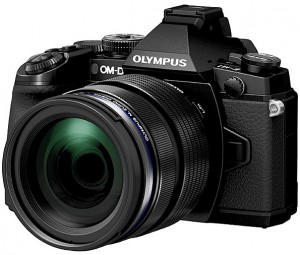 Today, Olympus announces the new E-M1 professional-level Micro Four Thirds camera. This camera represents a combination of features and is fully capable of using legacy Four Thirds with phase detect auto focus. The body is slightly larger than the E-M5, with a deeper grip and improved button and dial layout for one-handed operation. The E-M1 marks the end of the Four Thirds camera line, there will be no E-7 or any further camera past the the E-5.
Today, Olympus announces the new E-M1 professional-level Micro Four Thirds camera. This camera represents a combination of features and is fully capable of using legacy Four Thirds with phase detect auto focus. The body is slightly larger than the E-M5, with a deeper grip and improved button and dial layout for one-handed operation. The E-M1 marks the end of the Four Thirds camera line, there will be no E-7 or any further camera past the the E-5.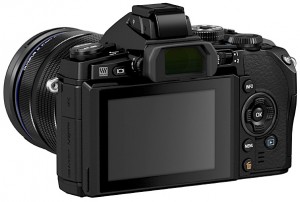 The electronic view finder (EVF) is all-new with 2.36 million dots and 1.48X magnification. The refresh rate is quick, with only 29 millisecond display lag. The built-in eye sensor switches between EVF and LCD rear tilting display.
The electronic view finder (EVF) is all-new with 2.36 million dots and 1.48X magnification. The refresh rate is quick, with only 29 millisecond display lag. The built-in eye sensor switches between EVF and LCD rear tilting display.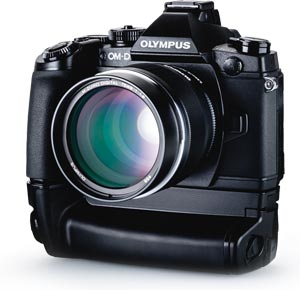
and $2199 with the 12-40mm f/2.8 PRO Lens. The E-M1 will ship in early October 2013.
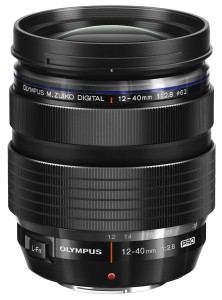 Along with the E-M1, Olympus announces the Micro Four Thirds PRO lens line. The first lens is the Olympus M Zuiko Digital ED 12-40mm f/2.8 PRO Lens
Along with the E-M1, Olympus announces the Micro Four Thirds PRO lens line. The first lens is the Olympus M Zuiko Digital ED 12-40mm f/2.8 PRO Lens which will retail at $995 US Dollars. The lens features a 3.3X zoom range which is equivalent to 24-80mm in 35mm terms. The lens features an all-metal construction with 14 elements in nine groups. The lenses include two aspherical elements (one one-sided and one dual-sided), 2 ED glass elements, 2 HR glass elements, 1 EDA glass element and 1 HD glass element. The lens has a function button and uses a 62mm filter thread. The fast aperture of f2.8 is constant throughout the zoom range. The lens is fully weather sealed for splash and dust protection in addition to freeze-proof like the E-M1 body. The lens is movie and still (MSC) compatible with quiet auto focus for HD movies. The seven curved aperture blades produce pleasing out of focus backgrounds. Unlike lower-end Olympus lenses, the PRO line includes accessories. The 12-40mm includes a petal lens hood (LH-66) and aluminum lens cap (LC-62D), rear cap (R-2) and lens pouch (LSC 0918). A one-year warranty is included.
